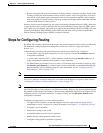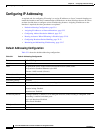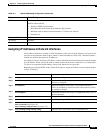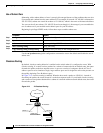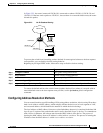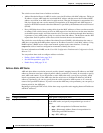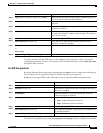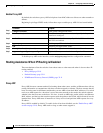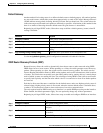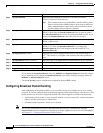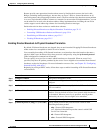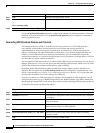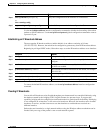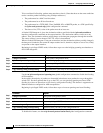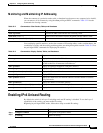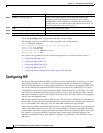
32-11
Cisco ME 3400 Ethernet Access Switch Software Configuration Guide
78-17058-01
Chapter 32 Configuring IP Unicast Routing
Configuring IP Addressing
Default Gateway
Another method for locating routes is to define a default router or default gateway. All nonlocal packets
are sent to this router, which either routes them appropriately or sends an IP Control Message Protocol
(ICMP) redirect message back, defining which local router the host should use. The switch caches the
redirect messages and forwards each packet as efficiently as possible. A limitation of this method is that
there is no means of detecting when the default router has gone down or is unavailable.
Beginning in privileged EXEC mode, follow these steps to define a default gateway (router) when IP
routing is disabled:
Use the no ip default-gateway global configuration command to disable this function.
ICMP Router Discovery Protocol (IRDP)
Router discovery allows the switch to dynamically learn about routes to other networks using IRDP.
IRDP allows hosts to locate routers. When operating as a client, the switch generates router discovery
packets. When operating as a host, the switch receives router discovery packets. The switch can also
listen to Routing Information Protocol (RIP) routing updates and use this information to infer locations
of routers. The switch does not actually store the routing tables sent by routing devices; it merely keeps
track of which systems are sending the data. The advantage of using IRDP is that it allows each router
to specify both a priority and the time after which a device is assumed to be down if no further packets
are received.
Each device discovered becomes a candidate for the default router, and a new highest-priority router is
selected when a higher priority router is discovered, when the current default router is declared down,
or when a TCP connection is about to time out because of excessive retransmissions.
The only required task for IRDP routing on an interface is to enable IRDP processing on that interface.
When enabled, the default parameters apply. You can optionally change any of these parameters.
Beginning in privileged EXEC mode, follow these steps to enable and configure IRDP on an interface:
Command Purpose
Step 1
configure terminal Enter global configuration mode.
Step 2
ip default-gateway ip-address Set up a default gateway (router).
Step 3
end Return to privileged EXEC mode.
Step 4
show ip redirects Display the address of the default gateway router to verify the
setting.
Step 5
copy running-config startup-config (Optional) Save your entries in the configuration file.
Command Purpose
Step 1
configure terminal Enter global configuration mode.
Step 2
interface interface-id Enter interface configuration mode, and specify the Layer 3 interface to
configure.
Step 3
no shutdown Enable the interface if necessary. By default, UNIs are disabled and NNIs
are enabled.
Step 4
ip irdp Enable IRDP processing on the interface.



